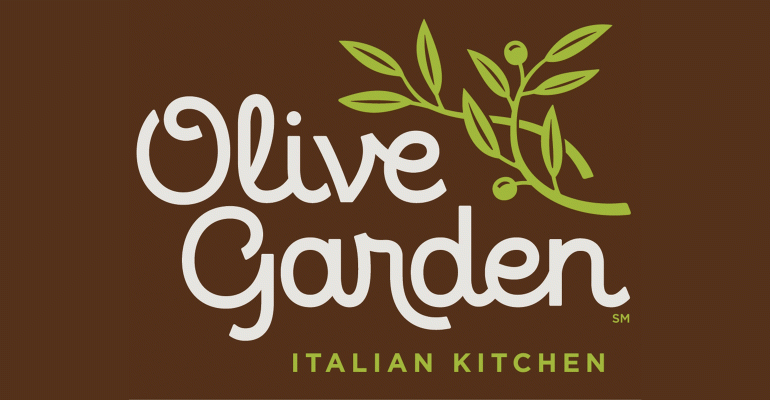Olive Garden’s same-store sales outperformed the casual-dining segment by more than 5 percentage points in its most recent quarter, parent company Darden Restaurants Inc. said Tuesday, as the chain lured customers with value offerings and to-go service.
Same-store sales at the 842-unit Italian chain rose 2.6 percent in the second quarter ended Nov. 27.
The results were 540 basis points higher than the casual-dining segment as a whole, without taking into account Darden’s six other concepts, according to the Knapp-Track casual-dining index. The performance was especially strong considering sustained struggles at casual-dining restaurants.
“Our approach continues to be effective,” Darden CEO Gene Lee said during the company’s earnings call Tuesday. “But we still have opportunities to improve in all aspects of the business.”
Lee attributed Olive Garden’s success to a multitude of strategies, including value offers, to-go orders and the company’s emphasis on service.
Olive Garden ran two strong value promotions in the second quarter, including a buy-one-take-one offer. Customers received two entrees for the price of one, one of which they could take home with them.
The chain’s Never Ending Pasta Bowl was also successful. In September, Olive Garden put 21,000 Never Ending Pasta Passes up for sale for $100 apiece. The deal let customers eat as much pasta as they’d like in October and November.
The Never Ending Pasta Passes sold out in one second, Darden said.
“We had a lot of great publicity around the Pasta Pass,” Lee said. ‘We’re excited about that promotion.”
Olive Garden’s takeout business also thrived. To-go orders increased 21 percent in the quarter, and have risen 50 percent over three years.
“We definitely saw great momentum with takeout,” Lee said.
That momentum could be important in the coming quarter: Valentine’s Day is traditionally Olive Garden’s strongest day for takeout orders.
Olive Garden’s pasta travels well, and the chain has worked hard on efforts to market to-go orders, as well as catering, which it will also deliver. Lee suggested during the company’s earnings call that it will take a deeper dive into delivery.
Lee said Darden has “multiple tests going on with all the big players” for single-order delivery. He hinted that negotiations are over the price Darden would have to pay for third parties to deliver its food to customers.
“They want us, and we want them,” Lee said. “We have to figure out how to make this work for both parties from a financial standpoint.”
Service is another key driver. The company has focused on restaurant-level execution to improve service, and Olive Garden had all-time high scores on customer satisfaction and “server attentiveness” in the quarter.
Lee said Darden has worked on its own strengths, and isn’t focused on elements it can’t control, such as weather.
“The weather is going to be what the weather is going to be,” Lee said. “There’s no impact long term on momentum and the overall value of the brand. If it snows on a Saturday, it snows on a Saturday. But it won’t snow on Saturday next year. The only things we can work on are things we can control.”
Revenue in the second quarter increased 2.1 percent, to $1.64 billion, from $1.61 billion the previous year. Net earnings were $79.5 million, or 64 cents per share, an increase of 84 percent from $43.2 million, or 33 cents per share a year ago.
Same-store sales rose at most of Darden’s seven concepts, including 0.1 percent at LongHorn Steakhouse, 2.7 percent at Eddie V’s, 1.2 percent at The Capital Grille, 2.6 percent at Bahama Breeze and 0.7 percent at Yard House. Same-store sales fell 0.3 percent at Seasons 52. Overall same-store sales increased 1.7 percent.
Traffic at LongHorn Steakhouse fell 1.1 percent. Lee suggested that the brand needs to simplify operations so it can improve service, even while easing labor costs.
“There’s too much activity, too many things on the table, and it is not enhancing overall dining,” Lee said. “Part of the strategic choice in LongHorn is to simplify. The business over the years has become too complicated. It needs to be a high-food-cost, low-labor-cost model. And simplification is a big part of it.
“We’re not overly concerned with little movement … as we try to undo some things that weren’t done for the right reasons for the brand in the past.”
Lee added that Darden is slowing down development at 485-unit LongHorn to focus on the basics.
“We may not have paid enough attention for service,” he said.
Executives said they expect labor costs to increase in the coming quarters, and said that competition for workers is driving up wages. Lee said the company is giving managers the flexibility to adapt to these higher wages.
“We’re operating in a low unemployment situation,” Lee said. “We have parts of our operation in geographies where unemployment is extremely low. We’re seeing a lot of wage inflation in those markets. We have adjusted our practices to ensure management teams have tools and flexibility they need to pay people based on the environment in which they are operating.”
Despite the increase in labor costs, Lee sees a bright side.
“Historically, these environments have turned out to be great for our business,” he said. “I’m optimistic that the wage inflation we’re seeing is going to turn into discretionary income, and we’ll see it back in our restaurants.”
Contact Jonathan Maze at [email protected]
Follow him on Twitter: @jonathanmaze

